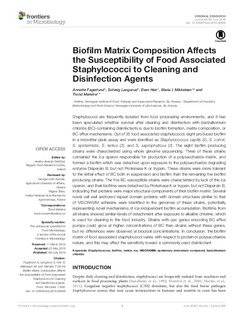| dc.description.abstract | Staphylococci are frequently isolated from food processing environments, and it has been speculated whether survival after cleaning and disinfection with benzalkonium chloride (BC)-containing disinfectants is due to biofilm formation, matrix composition, or BC efflux mechanisms. Out of 35 food associated staphylococci, eight produced biofilm in a microtiter plate assay and were identified as Staphylococcus capitis (2), S. cohnii, S. epidermidis, S. lentus (2), and S. saprophyticus (2). The eight biofilm producing strains were characterized using whole genome sequencing. Three of these strains contained the ica operon responsible for production of a polysaccharide matrix, and formed a biofilm which was detached upon exposure to the polysaccharide degrading enzyme Dispersin B, but not Proteinase K or trypsin. These strains were more tolerant to the lethal effect of BC both in suspension and biofilm than the remaining five biofilm producing strains. The five BC susceptible strains were characterized by lack of the ica operon, and their biofilms were detached by Proteinase K or trypsin, but not Dispersin B, indicating that proteins were major structural components of their biofilm matrix. Several novel cell wall anchored repeat domain proteins with domain structures similar to that of MSCRAMM adhesins were identified in the genomes of these strains, potentially representing novel mechanisms of ica-independent biofilm accumulation. Biofilms from all strains showed similar levels of detachment after exposure to alkaline chlorine, which is used for cleaning in the food industry. Strains with qac genes encoding BC efflux pumps could grow at higher concentrations of BC than strains without these genes, but no differences were observed at biocidal concentrations. In conclusion, the biofilm matrix of food associated staphylococci varies with respect to protein or polysaccharide nature, and this may affect the sensitivity toward a commonly used disinfectant. | nb_NO |

